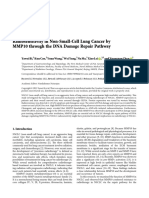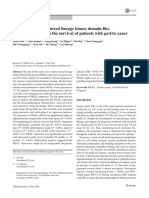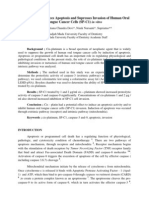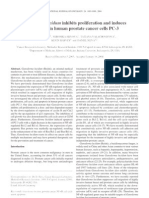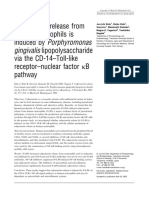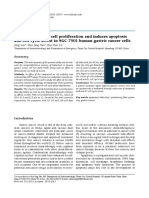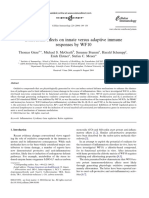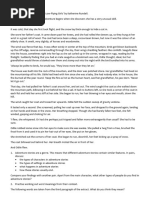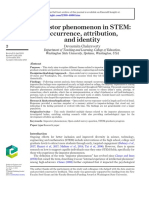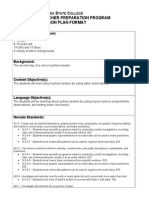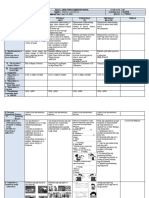Jcinvest00043 0362
Jcinvest00043 0362
Uploaded by
api-26848049Copyright:
Available Formats
Jcinvest00043 0362
Jcinvest00043 0362
Uploaded by
api-26848049Original Title
Copyright
Available Formats
Share this document
Did you find this document useful?
Is this content inappropriate?
Copyright:
Available Formats
Jcinvest00043 0362
Jcinvest00043 0362
Uploaded by
api-26848049Copyright:
Available Formats
Alkylating Agents and Immunotoxins Exert
Synergistic Cytotoxic Activity against Ovarian Cancer Cells
Mechanism of Action
Yaron J. Lidor,t Kathy C. O'Briant,* Feng J. Xu,* T. C. Hamilton,' R. F. Ozols, Robert C. Bast, Jr*
*Department ofMedicine, Duke University Medical Center, Durham, North Carolina 27710; * Department of Obstetrics and Gynecology,
University of Colorado Health Sciences Center, Denver, Colorado 80262; and §Fox Chase Cancer Center,
Philadelphia, Pennsylvania 19111
Abstract aggressively with platinum-based combination chemotherapy.
Most patients respond to cytotoxic chemotherapy and many
Alkylating agents can be administered in high dosage to pa- appear to be cured on clinical evaluation. Unfortunately, a
tients with ovarian cancer using autologous bone marrow sup- majority of these patients will develop recurrent disease refrac-
port, but drug-resistant tumor cells can still persist. Immuno- tory to other available therapy. This is felt to result from the
toxins provide reagents that might eliminate drug resistant regrowth of drug resistant tumor cells. Thus, there is a major
cells. In the present study, concurrent treatment with alkyla- need to find approaches to prevent or reverse drug resistance
tors and immunotoxins proved superior to treatment with each when it occurs.
agent alone. Toxin immunoconjugates prepared from different Immunotoxins are anticancer agents produced by conjuga-
monoclonal antibodies and recombinant ricin A chain (rRTA) tion of an antibody and a toxin. The antibody permits selective
inhibited clonogenic growth of ovarian cancer cell lines in limit- targeting of the toxin to tumor cells (1) . Since the mechanisms
ing dilution assays. When alkylating agents and toxin conju- by which immunotoxins exert their cytotoxic effects differ
gates were used in combination, the addition of the immunotox- from those ofalkylating agents including platinum drugs, toxin
ins to cisplatin, or to cisplatin and thiotepa, produced synergis- immunoconjugates could potentially eliminate alkylator resis-
tic cytotoxic activity against the OVCA 432 and OVCAR III tant cells. Moreover, the concurrent use of alkylators and im-
cell lines. munotoxins in combination might prove superior to treatment
Studies performed to clarify the mechanism of action with the individual agents alone.
showed that cisplatin and thiotepa had no influence on internal- In a previous study, serial dilution clonogenic assays were
ization and binding of the 317G5-rRTA immunotoxin. Intracel- used to evaluate the impact of alkylating agents on growth of
lular uptake of 119lPt-cisplatin was not affected by the immu- established ovarian cancer cell lines (2). Isobolographic analy-
noconjugate and thiotepa. The combination of the 317G5- sis showed that the combinations of cisplatin together with
rRTA and thiotepa, as well as 317G5-rRTA alone, increased thiotepa, melphalan, or 4-hydroxyperoxy-cyclophosphamide
1195Pt cisplatin-DNA adduct levels. The immunotoxin alone exerted synergistic cytotoxic activity against the OVCA 432,
and in combination with the alkylators decreased intracellular 420, 429, and 433 cell lines. Other studies have shown that
glutathione levels and reduced glutathione-S-transferase activ- immunotoxins exert cytotoxic and antitumor effects against
ity. Repair of DNA damage induced by the combination of alky- ovarian cancer cell lines and heterografts (3, 4). The effects of
lators and 317G5-rRTA was significantly reduced when com- concurrent treatment of ovarian cancer cells with immunotox-
pared to repair after damage with alkylators alone. These find- ins and alkylators has not, however, been previously described.
ings suggest that immunotoxins affect levels and activity of In the present study, we have shown that immunotoxins
enzymes required for the prevention and repair of alkylator prepared from two distinct monoclonal antibodies and recom-
damage. (J. Clin. Invest. 1993.92:2440-2447.) Key words: cis- binant ricin A chain (rRTA) 1 could synergistically enhance the
platin * ovarian neoplasms * immunoconjugates * drug synergy cytotoxic activity of a combination of alkylating agents against
the OVCA 432 and OVCAR III cell lines. Possible mechanisms
Introduction that may explain, in part, the observed synergistic interaction
have been evaluated.
Most ovarian cancer is diagnosed in advanced stage and, there-
fore, cannot be cured by surgery. Thus, after excision of as Methods
much tumor as possible, ovarian cancer patients are treated
Cell lines
OVCA 432 was established from a human ovarian cancer of epithelial
Address correspondence to Robert C. Bast, Jr., M.D., Duke University origin (5). OVCAR III was purchased from American Type Culture
Medical Center, Duke Comprehensive Cancer Center, P.O. Box 3843, Collection (Rockville, MD) (6). Cells were maintained in Eagle's min-
Durham, NC 27710. imum essential medium with Earle's salts (OVCA 432), or RPMI 1640
Receivedfor publication 19 May 1992 and in revisedform 21 June
1993.
J. Clin. Invest. 1. Abbreviations used in this paper: BSO, buthionine sulfoximine; cis-
©) The American Society for Clinical Investigation, Inc. platin, cis-diamminedichloro-platinum (II); GSH, glutathione; GST,
0021-9738/93/11/2440/08 $2.00 glutathione-S-transferase; SSA, S-sulfosalicylic acid; TCM, tissue cul-
Volume 92, November 1993, 2440-2447 ture media; thiotepa, trimethyleneiminethiophosphoramide.
2440 Lidor, O'Briant, Xu, Hamilton, Ozols, and Bast
(OVCAR III), supplemented with 10% heat inactivated FBS, 1 mM Internalization of 31 7G5-rRTA into drug-treated cells
L-glutamine, 1 mM sodium pyruvate, nonessential amino acids (0.1 The 317G5-rRTA conjugate was labeled with Na 125I using the iodogen
mM each), 100 ,g/ml streptomycin, and 100 U/ml penicillin (tissue method ( 14). Internalization was measured as previously described
culture media [TCM]). Unless otherwise indicated, cells were trypsin- (15). Briefly, radioiodinated 317G5-rRTA (I g/ml) was incubated
ized before the experiments and aliquoted in 5-ml polypropylene tubes. with drug-treated OVCA 432 cells (5 X 105) at 4VC for 1 h. After
Trypsinized cells were treated with drugs or immunotoxin at 370C in removal of excess conjugate with cold culture medium containing 1%
an atmosphere of 5% CO2 and 95% humidified air for 3 h on a rocking BSA, the cells were incubated either at 40C or 370C for a period of 4 h,
platform. and then treated with proteinase K ( 100 Ml of2.5 mg/ml solution) for 1
h at 370C with gentle shaking. Cells were then washed three times with
Drugs and immunoconjugates cold medium containing 1% BSA and 0.1% NaN3. Radioactivity was
Cisplatin (cis-diamminedichloro-platinum [ II ]) (Bristol-Myers Co., measured in a gamma counter (Packard Instruments (Meriden, CT).
New York) was stored at room temperature, and thiotepa (tri-methyl-
eneiminethiophosphoramide) (Lederle Laboratories, Pearl River, Uptake of['95mlPt-cisplatin
NY) was stored at 4VC. Alkylating agents were dissolved in H20 imme- Il9'm]Pt-cisplatin (84 ACi/mmol) was obtained from Oak Ridge Na-
diately before use and diluted to appropriate concentrations in TCM. tional Laboratories (Oak, Ridge, TN). Cell size was determined with a
rRTA was generously provided by Cetus Corp., Emeryville, CA. The Coulter electronic particle counter equipped with a channel analyzer
317G5 murine monoclonal antibodies were obtained as described (7). (models ZB and C 1000; Coulter Electronics, Hialeah, FL).
The BT 1 IA9. 13 antibody was prepared in ourlaboratory after immuni- The uptake of 19smlPt-cisplatin was determined as described before
zation of mice with BT20 breast cancer cells. Both 317G5 and (16) with minor variations. Briefly, 2 X 106 OVCA 432 cells were
BTl 1A9.13 bind to a 42-43-kD glycoprotein on the cell surface of incubated in 5-ml polypropylene tubes with different concentrations of
human breast and ovarian cancer cells (8). The preparation of the 1'95mlPt-cisplatin (10-100 Mmol) for 0.5-30 min, in a volume of 1 ml
rRTA conjugates was previously described (9). TCM at 37-C. A 600-Al aliquot of each sample was then diluted 10-fold
with ice-cold 0.9% NaCl, and cells were centrifuged at 500 g for 5 min
Serial dilution clonogenic assay and isobolographic at 4C. The pellet was washed twice with ice-cold 0.9% NaCl and solubi-
analysis lized overnight at 37°C in Aquasol-2 (New England Nuclear Research
Drug cytotoxicity was evaluated using a limiting dilution technique as Products, Boston, MA). Radioactivity was measured in a scintillation
described previously ( 10). Briefly, after trypsinization, 106 tumor cells counter (Tri-carb 4640). Uptake velocity was calculated from the lin-
were incubated with drugs and/or immunotoxins in a total volume of ear portion of a curve after correction for the initial rapid binding of the
1 ml. Cells were then washed twice with TCM. A series of nine fivefold drug. The reciprocal velocities were plotted against the reciprocal
dilutions was prepared. Six aliquots ( 100 Ml) of each dilution were ['9'm]Pt-cisplatin concentrations. The resulting Lineweaver-Burk plots
plated in 96-well flat-bottomed microtiter plates that had been pre- were analyzed by linear regression and the Km and V. of each treat-
loaded with 100 ,l TCM. Plates were incubated for 14 d at 37°C in 5% ment modality were determined from the slopes and intercepts of these
CO2 and 95% humidified air. Growth ofcolonies (> 50 cells) was evalu- plots. Data were also analyzed for two-component transport without
ated by visual scoring (2). Each value was calculated from a mean of correction for the initial rapid binding of the drug according to the
duplicate plates. Limiting-dilution analysis was performed as de- formula of Neal ( 17).
scribed (10).
Isobolographic analysis, a geometric method to explore drug inter- Intracellular levels ofglutathione (GSH)
actions, was performed as described by Berenbaum (1 1, 12) and Steel Cells (2-5 X 106; 60% confluent) were lysed by sonication in 1 ml of
and Peckham (13). Isoboles for different levels of cytotoxicity were PBS at 4°C. The supernatant was obtained for assay after centrifuga-
drawn from dose-response curves, in which the log effect by dose of one tion (10,000 g, 10 min, 40C). The protein was precipitated by adding
agent was plotted for each constant dose of the other agents in the 12% 5-sulfosalicylic acid (SSA) (1 vol SSA to 3 vol of sample). After
combination. The calculation of an "envelope of additivity" between standing on ice for 1-4 h, the samples were centrifuged (10,000 g, 10
modes I and II, which indicated the theoretical limits of the additive min). The SSA extract was assayed as described by Tietze ( 18) and
effects obtained from an interaction of two agents, is described else- modified by Griffith ( 19, 20), using 100 ,l of sample and 0.5 U of
where (2, 13). glutathione reductase per assay. Protein in the PBS lysate was deter-
An interaction between three agents was considered to be synergis- mined by the Lowry assay (21) (Bio-Rad Laboratories, Richmond,
tic when the combined cytotoxic effects exerted by the three different CA) using bovine serum albumin as standard.
agents created a concave isobolar surface (the surface joining all the
dose combinations producing a given quantitative effect). According Intracellular activity ofglutathione-S-transferase (GST)
to Berenbaum ( 1 1), the interaction between three agents could be gen- Activity was measured with l-chloro-2,3-dinitrobenzene (22). The
eralized using the iso-effective dose fraction formula: PBS extract (above) was used after centrifugation. The reaction mix-
ture contained glutathione (1 mM), l-chloro-2,3-dinitrobenzene (1
<< I1 for synergy mM), and sample (100 ,uM) in a final volume of 1 ml. The rate of
dose of+e
+T doseC of = 1 for additivity
A dose of B C .
increase in absorbance at 340 nm was measured at 250C. The results
> 1 for antagonism, are expressed as nmol/min per 106 cells.
where A, B, and C are doses of three drugs used in combination to DNA repair
produce a certain effect, whereas Ae, Be, and Ce are the doses of those [195mlPt-cisplatin DNA adducts. Drug-treated cells (2 X 107) were
drugs used alone to produce the same effect. When doses of drugs A, B, treated with 50 Mm of 1'9'mJPt-cisplatin (123 ,Ci/mmol) on a rocking
and C are represented by three coordinate axes, one can analyze their platform for 1 h at 37°C. Cells were washed twice in PBS, once in 0.144
interaction geometrically. Thus, if the doses of A, B, and C are repre- M NH4Cl with 0.01 M NaHCO3 ( 10:1 vol/vol), and lysed with 0.5%
sented by points on three axes, then the points representing all doses SDS in TNE buffer (10 mM Tris HCl, pH 8.2, 400 mM NaCl, and 2
and dose combinations with the same effect as Ae, Be, and Ce will lie on mM EDTA). Cell lysate was then mixed with proteinase K (250 tg/
the plan connecting these three points. The isobolar surface is flat when ml) and incubated at 37°C for 3 h. After phenol/chloroform extrac-
all the combinations of A, B, and C producing a certain effect are tion and ethanol precipitation (23), the DNA was dissolved in 200 Al of
additive (and the sum of the iso-effective dose fractions constituting TE buffer, pH 8.0, and quantitated in a mini fluorometer (model TKO
any combination of this surface equals 1). The isobolar surface for 100; Hoefer Scientific Instruments, San Francisco, CA) . Radioactivity
synergy is concave and the sum of these fractions is < 1. was quantitated as described above. Radiolabeled cisplatin-DNA ad-
Cytotoxicity with Alkylating Agents and Immunotoxins 2441
.0
l C)
Cil
C
C-.
t ~~~~~~~.n
CZ)
-;Cn)
Ol CC
CZ
_o o (.
w:
C
iD
wX A~~~X
I
ts~~~~~~~
.
ll\ c i
I I
.-
r4
N
0
o 0 _~ ~~~~~~~~~~~~~~~~~~~~~~
= D
rl)
~~~~oD 0
o~ o
--4
(IW/Bd) Vibl-SO 1 oo
co
(juiw/5d) VIH-S99 L °
o Q~~~
20
U)
00
OC
_ Co
0
C,)
-r
-C)
Cd 0
OC
F-
-CI
I~~~~~ZOC
0CZ
to
0CC CZ
-4
C ~~~~~O
I=I/ h-
(}V- w I
Z
IT
Qm
oS
7b ~ ~~~~~~
=.
o~~~~~~~~~~c
_ 4 .._
= - ~~~~~~~~~~~~- cr
(wiw5d) Vi8-SOL LC
(iw,5M) V1.9 OL c
2442 Lidor, O'Briant, Xu, Hamilton, Ozols, and Bast
duct levels were expressed in picograms of cisplatin per nanograms
of DNA.
Unscheduled DNA synthesis. Unscheduled DNA synthesis after -- ISOBOLOGRAM
drug damage was taken as a measure of total DNA repair activity. The ......
assay was performed according to a modification (24, 25) of a standard ...~~~_MODE
I
w M
......
D
procedure (26, 27). In summary, exponentially growing OVCA 432
£ -_ MODE 11
cells in TCM were prelabeled with 0.004 ACi/ ml [ '4C]deoxythymidine ....................................................".......................I..............
(54 mCi/mmole; New England Nuclear) for 24 h. 48 h later, the cells z
were harvested, pooled, and seeded in culture dishes ( 100 X 20 cm). At
full confluency, TCM was replaced with arginine-deficient medium -J
containing 2.5% dialyzed FBS, and medium was replaced every 24 h 0
CO
for a total of 72 h to decrease replicative DNA synthesis. To further
suppress and to density label any residual replicative DNA synthesis, 1
hydroxyurea (2 MM) and bromodeoxyuridine (10 AM) were then
added to the cultures. Treatment with alkylating agents and/or im-
munotoxins began 2 h thereafter. Cells were treated with drug and
immunotoxin combinations for 3 h and washed three times with PBS. 2 3 4
Cells were then incubated with 5 MCi [3H]deoxythymidine/ml (80
Ci/mmol; New England Nuclear) in arginine-deficient medium con- 317G5-rRTA (pg/ml)
taining 2.5% dialyzed FBS, hydroxyurea, and bromodeoxyuridine for 4 Figure 2. Synergistic cytotoxic interaction of cisplatin (CPPD) and
h, to radiolabel and density label the postdamage unscheduled DNA 317G5-rRTA against the cisplatin-resistant OVCAR III cell line.
synthesis. Dishes were then washed three times with cold PBS and the Modes I and II enclose an envelope of additivity for 1.5 log reduction
cells were solubilized with 1 ml 10 mM Tris-HCl, 1 mM EDTA (pH 8), of clonogenic cell growth. The isobole of the combined effect is mostly
0.5% sodium dodecyl sulfate, and 200 Ml 5 N NaOH, to which 0.15 M supra-additive, since it falls below the envelope of additivity.
NaCl and 0.015 M sodium citrate was added to a total lysate weight of
4.8 g. Each lysate was added to 6-g portions of CsCl in polyallomer
centrifuge tubes to obtain a density of - 1.72 g/ml and centrifuged to
equilibrium at 100,000 g for 36 h. Multiple fractions of 0.5 ml were added to cisplatin alone or to a combination of cisplatin and
obtained from each gradient and DNA was collected on cellulose filters thiotepa.
( 17 Chr; Whatman Inc., Clifton, NJ). Filters were then washed with The synergistic effect against OVCAR III was maintained
5% cold trichloroacetic acid and 100% ethanol and acetone for 5 min when 31 7G5-rRTA was replaced with BT 1 1 A9. 1 3-rRTA (Fig.
each and allowed to dry. Radioactivity was determined as described 3). 317G5 and BT 1 IA9. 13 recognize different epitopes on the
above with correction for '4C and 3H channel overlap. Fractions com- same 42-kD cell surface glycoprotein expressed by human
prising the t4C peak were pooled and dialyzed against water for < 24 h. breast and ovarian cancer cells.
The DNA content of the normal density DNA was determined spectro- Internalization of3J 7G5-rRTA into drug-treated cells. One
photometrically. The '4C-specific activity of the DNA was calculated
and repair activity was expressed as 3H counts per minute per micro- important determinant of the cytotoxic activity exerted by ri-
gram of DNA. The difference of 3H counts per minute per microgram cin A chain on malignant cells is the rate at which bound im-
of DNA between treated and control was used as an index of repair munotoxin is internalized into the cytoplasmic compartment.
activity. The conjugate is transported into receptosomes through
clathrin-coated pits in a process that might be influenced by
treatment with alkylators, since alkylating agents have been
Results shown to inhibit uptake of amino acids through the ASC car-
rier system (16), as well as to damage cell membranes (29).
Synergistic interaction between immunotoxin and cisplatin.
Using serial dilution clonogenic assays of OVCA432 growth,
dose response curves were generated for the cytotoxic effects of
cisplatin, thiotepa, and 317G5-rRTA, alone and in combina- 6
tion. Three-dimensional isobolographic analysis was then per- ISOBOLOGRAM
5
formed. Isoboles for 1.5, 2, 3, and 4 log-reduction of clonogenic r MODE
cell growth are plotted in Fig. 1, a-d, respectively. Three identi-
4 MODE 11
cal experiments were performed at different times and showed
similar results. The resultant concave isobolar surfaces indicate
that the three agents interacted synergistically over several z 3 1 \
orders of magnitude. Using a combination of agents, 99.99% of
-J
the cells could be killed. 2 ..
In a previous study, synergistic cytotoxic activity was ob- C/)
tained with a combination of cisplatin and several other alkylat- 1
ing agents against ovarian cancer cells that were sensitive to the
individual alkylators. Synergy could not be demonstrated 0
against the OVCAR III cell line, known to be resistant to cispla-
tin (2, 28). In the present study, using a combination of cispla- 0 1 2
tin and 31 7G5-rRTA, we obtained synergistic cytotoxic activ- BTI I A9.1I3-rRTA (pg/mi)
ity against OVCAR III (Fig. 2). Thus, supra-additive cytotoxic-
ity could be obtained against cisplatin resistant or cisplatin Figure 3. Synergistic cytotoxic interaction of cisplatin and
sensitive ovarian cancer cells when an immunotoxin was BTl 1 A9. 1 3-rRTA against the OVCAR III cell line.
Cytotoxicity with Alkylating Agents and Immunotoxins 2443
Experiments were carried out to measure the amount of 80
31 7G5-rRTA immunotoxin internalized into OVCA 432 cells
during 4 h incubation at 370C, after treatment of the cells with
cisplatin and thiotepa. Internalization was not affected by drug
treatment (Table I). The small reduction noted in the amount
of conjugate internalized into cells treated with both cisplatin a
and thiotepa was not statistically significant. In general, 2-3 ng
of immunotoxin were internalized into 5 X 105 cells in the 0
0
presence or absence of alkylating agents. Mil
AA --
Kinetic analysis of[1'9PPt-cisplatin uptake. Indirect data 0
suggest that uptake of platinum compounds involve an active q
carrier mechanism and that depletion of this carrier may affect * 317G5-rRTA
drug transport into the cells (27, 30). Since immunotoxins
may affect the carrier system, we compared the uptake of
20 1/ ... ......
*Th-"+
n +
317G5-rRTA
......
['9lmlPt-cisplatin into tumor cells that had been treated with
diluent or 31 7G5-rRTA in the presence or absence of thiotepa.
1"s
The initial uptake of 100 ,um cisplatin by OVCA 432 cells dur- 1 2 3 4 5 6 7 8 9 10
ing 10 min is illustrated in Fig. 4. Similar plots were obtained
with lower concentrations of cisplatin ( 10,25, and 50 Mm). The minutes
initial slope may reflect rapid binding of the drug to the plasma Figure 4. Uptake of 100 ,uM ll'sm-IN-cisplatin by 2 X 106 untreated
membrane before internalization actually occurs. Conse- OVCA 432 cells and cells exposed to 3 17G5-rRTA, with and without
quently, the Vmax and Km for each treatment modality were thiotepa, during the first 10 min of exposure.
calculated according to Neal (for two-component transport)
and Lineweaver-Burke (with correction for the initial rapid
binding) and were found to be similar (data not shown). These Intracellular levels of GSH also decreased somewhat after
findings indicate that the 3-h exposure to 317G5-rRTA and treatment with the immunotoxin and either single alkylating
thiotepa did not alter the regular uptake of cisplatin by the agent, but the decrease was not statistically significant.
OVCA 432 cells. Intracellular activity ofGST. Glutathione S-transferase cat-
Intracellular levels of GSH. Glutathione is a nonprotein alyzes reactions in which GSH, as a nucleophile, can bind to
tripeptide thiol that participates in many important cellular compounds bearing electrophilic atoms (33). As a result, the
functions, including protection from free radical damage and GST group of enzymes takes part in the detoxification of alkyl-
conversion of cytotoxic agents to less active compounds (31). ating agents, converting them to less active compounds (22,
Depletion of intracellular GSH renders cells more radiosensi- 34). The intracellular activity of GST was measured in OVCA
tive (28), and elevated GSH levels result in radioprotection 432 cells treated with alkylating agents and 31 7G5-rRTA. Glu-
and decreased sensitivity to many anticancer drugs (32). To tathione S-transferase activity in cells treated with the combina-
study the role played by glutathione in the interaction between tions of cisplatin, thiotepa, and 317G5-rRTA was lower than
31 7G5-rRTA and alkylating agents, we measured the intracel- the activity found in untreated cells and in those treated with
lular concentration of GSH after treatment of OVCA 432 cells the alkylators alone. A reduction of 22% was observed in cells
with diluent, alkylating agents, or immunotoxins. Glutathione treated with the three agents together as compared to the activ-
levels in cells treated with a combination of cisplatin, thiotepa, ity of GST found in the cells treated with cisplatin alone (Table
and 31 7G5-rRTA were lower than the levels found in the dilu-
ent treated cells or in cells treated with cisplatin alone (Table
II). The observed GSH depletion was statistically significant Table II. Effect of Treatment with Alkylating Agents and
and reproducible (Student's t test and ANOVA P < 0.003). Immunotoxins on GSH Levels in OVCA 432 Cells
Treatment GSH levels
Table I. Binding and Internalization of Immunotoxin by OVCA nM/J06 cells
432 Cells after Treatment with Cisplatin and Thiotepa
Diluent 41.5±1.6t
Immunotoxin bound Cisplatin 43.2±0.7*
4°C incubation followed 370C incubation followed Thiotepa 44.0±0.8*
Treatment by protease stripping by protease stripping Cisplatin/thiotepa 43.1±0.6t
ng/S x 105 cells 3 17G5-rRTA 40.6±0.2
Cisplatin/3 17G5-rRTA 41.0±0.2
Diluent 12.3±2.1 15.2±1.5 Thiotepa/3 17G5-rRTA 40.4±0.6
Cisplatin 11.7±0.7 14.5±0.5 Cisplatin/thiotepa/3 17G5-rRTA 36.1±0.2*
Thiotepa 12.9±0.3 15.4±0.5
Cisplatin/thiotepa 12.9±1.9 14.7±0.5 * P < 0.05 vs t Student's t test. (The variance of the group was statis-
tically significant.) Intracellular glutathione levels in 6 x 106 treated
Internalization of 1 gg/ml 317G5-rRTA into 5 X 106 drug-treated and untreated OVCA 432 cells. Cisplatin concentration, 1 uM; thio-
OVCA 432 cells. Each value represents the mean±SD for quintupli- tepa, 2 MM; 317G5-rRTA, 0.4 jig/ml. The experiment was repeated
cate samples of 5 x 106 cells. three times with triplicate samples of 6 x 106 cells.
2444 Lidor, O'Briant, Xu, Hamilton, Ozols, and Bast
aD~G
Table III. Effect of Treatment with Alkylating Agents 250 -
and Immunotoxins on Glutathione-S-transferase Levels
in OVCA 432 Cells
200
Treatment GST activity
nM conjugate/min c 150-
per ng protein
0
Diluent 374.9±2.6$ 100
fl-
Cisplatin 393.0±5.3t 100 -- .- I
Thiotepa 375.9+3.7t
Cisplatin/thiotepa 375.9±5.9* 0
317G5-rRTA 362.3±4.8t
Cisplatin/317G5-rRTA 354.6±3.2$ 50
Thiotepa/317G5-rRTA 332.1±8.7t 0~~~.
-..
Cisplatin/thiotepa/317G5-rRTA 308.3±3.8* Control Cisplatin Cisplatin Cisplatin Cisplatin
Thiotepa 317G5-rRTA Thiotepa
317G5-rRTA
* P < 0.05 vs t Student's t test. (The variance of the group was statis-
Figure 5. Cisplatin-DNA adduct formation in 1.5 x 107 OVCA 432
tically significant.) GST activity in 5 x 106 OVCA 432 cells treated cells after incubation with 50 jmol [l5mlPt<jisplatin. Cells were
with the combinations of 1 1M cisplatin, 2 AtM thiotepa, and 0.4 jig/ treated for 1 h with 2 ,gM thiopeta and 0.4 gg/ml 317G5-rRTA, nei-
ml 317G5-rRTA. GST activity in the supernatant was determined ther, or both.
spectrophotometrically at 340 nm by measuring the conjugation of
glutathione with 1 -chloro-2,4-dinitrobenzene and was expressed as
nanomoles of conjugate formed per minute per nanogram protein. with 317G5-rRTA in addition to the alkylators (P < 0.004,
Quadruplicates of 5 x 106 OVCA 432 cells were treated with each ANOVA P < 0.001).
agent as described above.
Discussion
III). This reduction was highly significant (Student's t test P
< 0.006 and ANOVA P < 0.008). Approximately 60-75% of ovarian cancer patients are diag-
Adduct formation. Intrastrand, interstrand, and DNA-Pt- nosed initially with advanced stage disease (40). Alkylating
protein adducts are formed when cisplatin binds covalently to agents have proven beneficial in the treatment of these patients
DNA. Intrastrand adducts are observed most frequently and (41, 42), but most often only temporary remissions are
exhibit sequence-specific binding of cisplatin to DNA forming achieved with platinum-based combination chemotherapy.
bidentate N7-deoxy (G-Pt-G) linkages between adjacent bases Thus, the long term survival of ovarian cancer patients with
on the same strand. Interstrand DNA-Pt adducts are composed bulky disease has only slightly improved during the last two
of cisplatin bound to two guanines on opposite DNA strands, decades (43-45). It is generally accepted that the emergence of
perturbing G-C base pairing, leading to unwinding and shorten- drug resistance is the cause for treatment failure (46, 47). If
ing of DNA (35-37). CDDP-DNA adduct formation in
OVCA 432 cells was studied after incubation with "'95m]Pt-
cisplatin. OVCA 432 cells were treated for 1 h with thiotepa,
317G5-rRTA, neither, or both agents. Cells were then incu- 14
bated for 1 h with or without '9smlPt-cisplatin. The concentra-
tion of cisplatin-DNA adducts in cells treated with a combina- < 12
tion of cisplatin, thiotepa, and 317G5-rRTA was about twice
that found in the cells treated with the alkylators (Student's t z - 1Wi 'l........
l
test P < 0.017 and ANOVA P < 0.008) (Fig. 5). A significant
increase in adduct formation was also observed in cells treated C
0.
zn| X1.n ce~ ~ ~ ~ ~ ~ ~ ~ ~ :il iil}
with a combination of cisplatin and 31 7G5-rRTA, when com-
pared to adducts formed in cells treated with alkylators alone 6 .''...'.!l..ll
.ii
.-sh.he...
.- i- ' zl"'- '.......
l!;'- ~ ~ ~ ~ ~ ~ ~.
P
(P<0.03). 1 iilll
IVltpe
DNA repair. DNA repair after alkylator damage can play a 4 -
major role in acquired resistance to cisplatin (38). The most it !:1
general repair mechanism known is nucleotide excision that
removes ultraviolet-induced lesions and chemical adducts
from damaged DNA (39). Excision repair of total cellular
DNA was evaluated in OVCA 432 cells by measuring unsche-
C Osplatir' ihiotepa 31 7G5 rRTA Cisplatin C'spiatn Cisolat nl
Thotepa 317G5 rRTA Thiotepa
duled DNA synthesis following alkylator damage. When com- ..A
317G-rT
pared to diluent treated cells, bulk repair activity was substan- Figure 6. Postdamage unscheduled DNA synthesis as a measure of
tially increased in cells treated with cisplatin (Fig. 6). When total DNA repair activity in OVCA 432 cells. Cells were exposed for
compared to levels of repair observed after treatment with cis- 3 h to 1 tiM CDDP, 2 tIM thiopeta, and 0.4 yg/ml 317G5-rRTA.
platin alone or in combination with thiotepa, a significant re- The difference of 3H cpm per micrograms of DNA between treated
duction of bulk repair activity was observed in cells treated and control was taken as the measurement of repair activity.
Cytotoxicity with Alkylating Agents and Immunotoxins 2445
such is the case, modulation of resistant cells should markedly of intracellular glutathione could account, at least in part,
improve the efficacy of chemotherapy in ovarian cancer. for the modulation of DNA repair observed in the present
In several preclinical studies, resistance to cisplatin in ovar- study (25).
ian cancer has been associated with increased cellular levels of Selective sensitization of tumor cells to alkylator damage
GSH, increased activity of GST, and increased DNA repair of could provide an additional therapeutic advantage, particu-
drug induced damage (48). Several compounds can partially larly in the setting of high dose therapy with autologous bone
restore the sensitivity of resistant ovarian cancer cells to alkylat- marrow support, where appropriate concentration of alkylat-
ing agents: buthionine sulfoximine (BSO), a specific inhibitor ing agents can be achieved in vivo. In this setting, immunotox-
of gamma-glutamyl cysteine synthetase, is capable of lowering ins might be given on a single occasion obviating the effects of
cellularGSH; aphidicolin, a specific inhibitor of DNA polymer- human antiovarian antibodies that arise after repeated injec-
ase a and y, can reduce DNA repair activity; and ethacrynic tions of murine immunoglobulins. The specificity of the im-
acid is capable of inhibiting GST. While, in theory, chemical munotoxin will also be important. The 317G5 antibody binds
modulators of drug resistance do not discriminate between to a 42-43-kD protein that can be found in a majority of ovar-
normal and malignant cells, in practice, their action appears to ian and breast cancers, as well as the normal epithelium of the
be more pronounced in malignant tissues. For example, BSO intestine and renal collecting tubules. Whether this specificity
reduced GSH concentration in most normal tissues studied, will permit effective use of 31 7G5 in clinical trials remains to
but the degree of reduction was frequently not as great as in be determined, but the principle of synergistic interactions may
tumor tissues, and toxicity to normal tissues was generally not apply to reagents with many different specificities.
augmented at BSO doses that enhanced chemotherapy against
human xenograft tumors (49). Consequently, both BSO and Acknowledgments
aphidicolin are currently undergoing early clinical trials This work was funded in part by grant PO1 CA47741 from the Na-
(48, 50). tional Cancer Institute, Department of Health, and Human Services.
Effects on normal cells produced by most potential chemi-
cal modulators ofanticancer drug resistance may limit the util- References
ity of those compounds. Extended exposure to BSO, some-
times critical fortherapeutic success ( 5 1 ), may potentiate toxic- 1. Blythman, H. E., P. Casellas, 0. Gros, P. Gros, F. K. Jansen, F. Paolucci, B.
Pau, and H. Vidal. 1981. Immunotoxins: hybrid molecules of monoclonal anti-
ity of alkylators to marrow progenitor cells (52). GSH bodies and a toxin subunit specifically kill tumour cells. Nature (Lond.).
depletion may also inhibit normal and activated lymphocytic 290:145-146.
proliferative response (53, 54). Aphidicolin may induce breaks 2. Lidor, Y. J., E. J. Shpall, W. P. Peters, and R. C. Bast, Jr. 1991. Synergistic
cytotoxicity of different alkylating agents for epithelial ovarian cancer. Int. J.
at fragile sites on human chromosomes and telomere associa- Cancer. 49:704-710.
tion in normal cells (55, 56). 3. Pirker, R., D. J. FitzGerald, T. C. Hamilton, R. F. Ozols, W. Laird, A. E.
In the present study, we have demonstrated that immuno- Frankel, M. C. Willingham, and I. Pastan. 1985. Characterization ofimmunotox-
toxins modulate sensitivity of ovarian cancer cells to alkyla- ins active against ovarian cancer cell lines. J. Clin. Invest. 76:1261-1267.
4. Willingham, M. C., D. J. FitzGerald, and I. Pastan. 1987. Pseudomonas
tors. In contrast to chemosensitizers such as BSO and aphidico- exotoxin coupled to a monoclonal antibody against ovarian cancer inhibits the
lin, immunotoxins have strong cytotoxic activity and this activ- growth of human ovarian cancer cells in a mouse model. Proc. Natd. Acad. Sci.
ity is produced by mechanisms distinct from alkylating agents. USA. 84:2474-2478.
5. Bast, R. C., Jr., M. Feeney, H. Lazarus, L. M. Nadler, R. B. Colvin, and
Thus, these agents may produce efficacy in two ways. First, by R. C. Knapp. 1981. Reactivity of a monoclonal antibody with human ovarian
direct action, and second, like BSO and aphidicolin, immuno- carcinoma. J. Clin. Invest. 68:1331-1337.
toxins may inhibit enzymes required for the prevention and 6. Hamilton, T. C., R. C. Young, W. M. McKoy, K. R. Grotzinger, J. A.
repair of alkylator damage. In a previous study, nontoxic doses Green, E. W. Chu, J. Whang-Peng, A. M. Rogan, W. R. Green, and R. F. Ozols.
1983. Characterization of a human ovarian carcinoma cell line (NIH: OVCAR-
of BSO decreased GSH levels in ovarian cancer cells to 20% of 3) with androgen and estrogen receptors. Cancer Res. 43:5379-5389.
control, potentiating cytotoxicity of alkylators in OVCA cells, 7. Bjorn, M. J., D. Ring, and A. Frankel. 1985. Evaluation of monoclonal
and reversing completely resistance to melphalan in the antibodies for the development of breast cancer immunotoxins. Cancer Res.
45:1214-1221.
1847ME OVCA cell line (57). In the present study, GSH deple- 8. Boyer, C. M., M. J. Borowitz, K. S. McCarty, Jr., R. B. Kinney, L. Everitt,
tion of up to 16.4% of controls was obtained with combinations D. V. Dawson, D. Ring, and R. C. Bast, Jr. 1989. Heterogeneity of antigen
of 317G5-rRTA and cisplatin, and synergistic modulation of expression in benign and malignant breast and ovarian epithelial cells. Int. J.
Cancer. 43:55-60.
cisplatin resistance in the OVCAR III cell line was observed. 9. Ramakrishnan, S., M. J. Bjorn, and L. L. Houston. 1989. Recombinant
Several enzymes take part in drug detoxification and in the ricin A chain conjugated to monoclonal antibodies: improved tumor cell inhibi-
removal of drug-induced free radicals by GSH (including tion in the presence of lysosomotropic compounds. Cancer Res. 49:613-617.
gamma-glutamyl cysteine synthetase, glutathione reductase, 10. Bast, R. C., Jr., P. De Fabritiis, J. Lipton, R. Gelber, C. Maver, L. Nadler,
S. Sallan, and J. Ritz. 1985. Elimination of malignant clonogenic cells from
and glutathione peroxidase). The effect of immunotoxins on human bone marrow using multiple monoclonal antibodies and complement.
enzymes other than GST remain to be explored, but based on Cancer Res. 45:499-503.
the mechanism of action of ricin, indirect effects might be antic- 1 1. Berenbaum, M. C. 1977. Synergy, additivism and antagonism in immuno-
suppression. A critical review. Clin. Exp. Immunol. 28:1-18.
ipated. Ricin toxin inactivates protein synthesis at the transla- 12. Berenbaum, M. C. 1989. What is synergy? Pharmacol. Rev. 41:93-141.
tional stage, by depurinatation of a single adenine base at the 13. Steel, G. G., and M. J. Peckham. 1979. Exploitable mechanisms in com-
28S rRNA of the 60S ribosomal subunit, near the elongation bined radiotherapy-chemotherapy: the concept of additivity. Int. J. Radiat. On-
factor 2 binding site (58, 59). Unlike BSO or aphidicolin, spe- col. Biol. Phys. 5:85-91.
14. Masuho, Y., M. Zalutsky, R. C. Knapp, and R. C. Bast, R. C., Jr. 1984.
cific inhibition of enzymes by ricin toxin has not been previ- Interaction of monoclonal antibodies with cell surface antigens of human ovarian
ously demonstrated. Thus, reduction of level or activity of en- carcinomas. Cancer Res. 44:2813-2819.
zymes participating in intracellular thiol and DNA repair path- 15. Yu, Y. H., J. R. Crews, K. Cooper, S. Ramakrishnan, L. L. Houston, D. S.
Leslie, S. L. George, Y. Lidor, C. M. Boyer, D. B. Ring, and R. C. Bast, Jr. 1990.
ways is most likely secondary to the general arrest of protein Use of immunotoxins in combination to inhibit clonogenic growth of human
synthesis induced by the immunotoxin. Moreover, depletion breast carcinoma cells. Cancer Res. 50:3231-3238.
2446 Lidor, O'Briant, Xu, Hamilton, Ozols, and Bast
16. Scanlon, K. J., R. L. Safirstein, H. Thies, R. B. Gross, S. Waxman, and cis-olamminedaicnloroplatinum (11) (cIsplatin) to L)NA. Blioclim. Blophys. Acta.
J. B. Guttenplan. 1983. Inhibition of amino acid transport by cis-diamminedi- 780:167-180.
chloroplatinum (II) derivatives in L1210 murine leukemia cells. Cancer Res. 38. Eastman, A., and N. Schulte. 1988. Enhanced DNA repair as a mecha-
43:4211-4215. nism of resistance to cis-diamminedichloroplatinum (II). Biochemistry.
17. Neal, J. L. 1972. Analysis of Michaelis kinetics for two independent, 27:4730-4734.
saturable membrane transport functions. J. Theor. Biol. 35:113-118. 39. Bohr, V. A. 1991. Gene specific damage and repair after treatment ofcells
18. Tietze, F. 1969. Enzymic method for quantitative determination of nano- with UV and chemotherapeutical agents. Adv. Exp. Med. Bio. 283:225-233.
gram amounts of total and oxidized glutathione: applications to mammalian 40. Gershenson, D. M. 1987. Chemotherapy for epithelial ovarian cancer. In
blood and other tissues. Anal. Biochem. 27:502-522. Gynecologic Cancer Diagnosis and Treatment Strategies. F. N. Rutledge, R. S.
19. Griffith, 0. W. 1980. Determination of glutathione and glutathione disul- Freedman and D. M. Gershenson, editors. University of Texas Press, Austin, TX.
fide using glutathione reductase and 2-vinylpyridine. Anal. Biochem. 106:207- pp. 4 1-60.
212. 41. Ozols, R. F., and R. C. Young. 1987. Ovarian cancer. Curr. ProbL. Cancer.
20. Friedman, H. S., S. X. Skapek, 0. M. Colvin, G. B. Elion, M. R. Blum, 11:57-122.
P. M. Savina, J. Hilton, S. C. Schold, Jr., J. Kurtzberg, and D. D. Bigner. 1988. 42. Gershenson, D. M., J. J. Kavanagh, L. J. Copeland, C. A. Stringer, M.
Melphalan transport, glutathione levels, and glutathione-S-transferase activity in Morris, and J. T. Wharton. 1989. Retreatment of patients with recurrent epithe-
human medulloblastoma. Cancer Res. 48:5397-5402. lial ovarian cancer with cisplatin-based chemotherapy. Obstet. Gynecol. 73:798-
21. Lowry, 0. H., N. J. Rosebrough, A. L. Farr, and R. J. Randall. 1951. 802.
Protein measurement with the folin phenol reagent. J. Biol. Chem. 193:265-275. 43. DiSaia, P. J. 1987. Concerns about ovarian epithelial cancer management.
22. Habig, W. H., M. J. Pabst, and W. B. Jakoby. 1974. Glutathione S-trans- Am. J. Clin. Oncol. 10:268-269.
ferases. The first enzymatic step in mercapturic acid formation. J. Bio/. Chem. 44. Creasman, W. T., and P. J. DiSaia. 1991. Screening in ovarian cancer. Am.
249:7130-7 139. J. Obstet. Gynecol. 165:7-10.
23. Maniatis, T., E. F. Fritsch, and J. Sambrook. 1982. Purification of nucleic 45. Lund, B., and P. Williamson. 1990. Prognostic factors for outcome of and
acids. In Molecular Cloning: A Laboratory Manual. Cold Spring Harbor Labora- survival after second-look laparotomy in patients with advanced ovarian carci-
tory Publication, Cold Spring Harbor, NY. pp. 458-459. noma. Obstet. Gynecol. 76:617-622.
24. Masuda, H., R. F. Ozols, G. M. Lai, A. Fojo, M. Rothenberg, and T. C. 46. Fidler, I. J., and G. Poste. 1985. The cellular heterogeneity of malignant
Hamilton. 1988. Increased DNA repair as a mechanism ofacquired resistance to neoplasms: implications for adjuvant chemotherapy. Semin. Oncol. 12:207-221.
cis-diamminedichloroplatinum (II) in human ovarian cancer cell lines. Cancer 47. Goldie, J. H., and A. J. Coldman. 1979. A mathematic model for relating
Res. 48:5713-57 16. the drug sensitivity of tumors to their spontaneous mutation rate. Cancer Treat.
25. Lai, G. M., R. F. Ozols, R. C. Young, and T. C. Hamilton. 1989. Effect of Rep. 63:1727-1733.
glutathione on DNA repair in cisplatin-resistant human ovarian cell lines. J. 48. Ozols, R. F., P. J. O'Dwyer, T. C. Hamilton, and R. C. Young. 1990. The
Natl. Cancer Inst. 81:535-539. role of glutathione in drug resistance. Cancer Treat. Rev. 1 7A:45-50.
26. Trosko, J. E., and J. D. Yager. 1974. A sensitive method to measure 49. Stewart, D. J., and W. K. Evans. 1989. Non-chemotherapeutic agents that
physical and chemical carcinogen-induced 'unscheduled DNA synthesis' in rap- potentiate chemotherapy efficacy. Cancer Treat. Rev. 16:1-40.
idly dividing eukaryotic cells. Exp. Cell Res. 88:47-55. 50. Sessa, C., M. Zucchetti, E. Davoli, R. Califano, F. Cavalli, S. Frustaci, L.
27. Smith, C. A., P. K. Cooper, and P. C. Hanawalt. 1981. Measurement of Gumbrell, A. Sulkes, B. Winograd, and M. D'Incalci. 1991. Phase I and clinical
repair replication by equilibrium sedimentation. In DNA repair. A Laboratory pharmacological evaluation of aphidicolin glycinate. J. Nati. Cancer Inst.
Manual of Research Procedures. E. C. Friedberg and P. C. Hanawalt, editors. 83:1160-1164.
Marcel Dekker, Inc., New York. pp. 289-305. 51. Robichaud, N. J., and R. J. Fram. 1990. Schedule dependence of buthion-
28. Louie, K. G., B. C. Behrens, T. J. Kinsella, T. C. Hamilton, K. R. Grot- ine sulfoximine in reversing resistance to cisplatin. Chem. Bio. Interact. 76:333-
zinger, W. M. McKoy, M. A. Winker, and R. F. Ozols. 1985. Radiation survival 342.
parameters of antineoplastic drug-sensitive and -resistant human ovarian cancer 52. Du, D. L., D. A. Volpe, C. K. Grieshaber, and M. J. Murphy, Jr. 1990.
cell lines and their modification by buthionine sulfoximine. Cancer Res. Effects of L-phenylalanine mustard and L-buthionine sulfoximine on murine and
45:2110-2115. human hematopoietic progenitor cells in vitro. Cancer Res. 50:4038-4043.
29. Fry, D. W., and R. C. Jackson. 1986. Membrane transport alterations as a 53. Hamilos, D. L., P. Zelarney, and J. J. Mascali. 1989. Lymphocyte prolifer-
mechanism of resistance to anticancer agents. Cancer Surv. 5:47-79. ation in glutathione-depleted lymphocytes: direct relationship between glutathi-
30. Bihler, I. Intestinal sugar transport: ionic activation and chemical specific- one availability and the proliferative response. Immunopharmacology. 18:223-
ity. Biochim. Biophys. Acta. 183:169-18 1. 235.
31. Meister, A., and M. E. Anderson. Glutathione. Annu. Rev. Biochem. 54. Smyth, M. J. 1991. Glutathione modulatesactivation-dependent prolifera-
52:711-760. tion of human peripheral blood lymphocyte populations without regulating their
32. Arrick, B. A., and C. F. Nathan. 1984. Glutathione metabolism as a activated function. J. Immunol. 146:1921-1927.
determinant of therapeutic efficacy: a review. Cancer Res. 44:4224-4232. 55. Caporossi, D., S. Bacchetti, and B. Nicoletti. 1991. Synergism between
33. Jakoby, W. B. 1985. Glutathione transferases: an overview. Methods En- aphidicolin and adenovirsuses in the induction ofbreaks at fragile sites on human
zymol. 113:495-499. chromosomes. Cancer Genet. Cytogenet. 54:39-53.
34. Ozols, R. F., and K. Cowan. 1986. New aspects of clinical drug resistance: 56. Fuster, C., R. Miro, L. Barrios, and L. Egozcue. 1990. Telomere associa-
the role of gene amplification and the reversal of resistance in drug refractory tion of chromosomes induced by aphidicolin in a normal individual. Hum.
cancer. In Important Advances in Oncology. V. T. DeVita, S. Hellman, and S. Genet. 84:424-426.
Rosenberg, editors. J. B. Lippincott Co., New York. 129-157. 57. Green, J. A., D. T. Vistica, R. C. Young, T. C. Hamilton, A. M. Rogan,
35. Dijt, F. J., A. M. Fichtinger-Schepman, F. Berends, and J. Reedijk. 1988. and R. F. Ozols. 1984. Potentiation of melphalan cytotoxicity in human ovarian
Formation and repair of cisplatin-induced adducts to DNA in cultured normal cancer cell lines by glutathione depletion. Cancer Res. 44:5427-5431.
and repair-deficient human fibroblasts. Cancer Res. 48:6058-6062. 58. Endo, Y., K. Mitsui, M. Motizuki, and K. Tsurugi. 1987. The mechanism
of action of ricin and related toxin lectins on eukaryotic ribosomes. The site and
36. Reed, E., S. H. Yuspa, L. A. Zwelling, R. F. Ozols, and M. C. Poirier. the characteristics of the modification in 28 S ribosomal RNA caused by the
1986. Quantitation of cis-diamminedichloroplatinum II (cisplatin) -DNA-intra- toxins. J. Bio. Chem. 262:5908-5912.
strand adducts in testicular and ovarian cancer patients receivingcisplatin chemo- 59. Moazed, D., J. M. Robertson, and H. F. Noller. 1988. Interaction of
therapy. J. Clin. Invest. 77:545-550. elongation factors EF-G and EF-Tu with a conserved loop in 23S RNA. Nature
37. Pinto, A. L., and S. J. Lippard. 1985. Binding of the antitumor drug (Lond.). 334:362-364.
Cytotoxicity with Alkylating Agents and Immunotoxins 2447
You might also like
- App Smash Math LessonDocument4 pagesApp Smash Math Lessonapi-454025924No ratings yet
- Cancro Do PulmãoDocument8 pagesCancro Do PulmãoDE Sousa Lps SusanaNo ratings yet
- Suppression of Human Immunodeficiency Virus Replication by Ascorbate in Chronically and Acutely Infected Cells.Document5 pagesSuppression of Human Immunodeficiency Virus Replication by Ascorbate in Chronically and Acutely Infected Cells.Hector Javier Chavez RamirezNo ratings yet
- CPG Island Hypermethylation-Associated Silencing of Micrornas Promotes Human Endometrial CancerDocument10 pagesCPG Island Hypermethylation-Associated Silencing of Micrornas Promotes Human Endometrial CancerFerdina NidyasariNo ratings yet
- Antibody Binding Profile of Purified and Cell-Bound CD26 1993Document14 pagesAntibody Binding Profile of Purified and Cell-Bound CD26 1993heyligenNo ratings yet
- GPT2 - Gls1 - Sensitivity - 2020Document12 pagesGPT2 - Gls1 - Sensitivity - 2020shravanvvNo ratings yet
- MGCTDocument11 pagesMGCTcandiddreamsNo ratings yet
- Anti-Proliferative Properties of Thymoquinone To Overcome Cisplatin-Induced Drug Resistance in SKOV-3Document8 pagesAnti-Proliferative Properties of Thymoquinone To Overcome Cisplatin-Induced Drug Resistance in SKOV-3mehulshah1126No ratings yet
- The cardioprotective effect of astaxanthin against isoprenaline-induced myocardial injury in rats: involvement of TLR4/NF-κB signaling pathwayDocument7 pagesThe cardioprotective effect of astaxanthin against isoprenaline-induced myocardial injury in rats: involvement of TLR4/NF-κB signaling pathwayMennatallah AliNo ratings yet
- Effet Glucane Reishi 19 Janv 2023Document8 pagesEffet Glucane Reishi 19 Janv 2023ilyNo ratings yet
- Resistance in Human Cervical Tumor Cells: Ercc1 Expression As A Molecular Marker of CisplatinDocument5 pagesResistance in Human Cervical Tumor Cells: Ercc1 Expression As A Molecular Marker of CisplatinAmanda Kelly N. MendonçaNo ratings yet
- Citosol (Thiamylal Sodium) Triggers Apoptosis and Affects Gene Expressions of Murine Leukemia RAW 264.7 Cells - RS-C Wu, C-S YuDocument1 pageCitosol (Thiamylal Sodium) Triggers Apoptosis and Affects Gene Expressions of Murine Leukemia RAW 264.7 Cells - RS-C Wu, C-S YuAlondra MaldonadoNo ratings yet
- MMP10 NSCLCDocument9 pagesMMP10 NSCLCbhaskarNo ratings yet
- Journal Pone 0091606Document9 pagesJournal Pone 0091606Vikneswaran VîçkýNo ratings yet
- Ertao 2016Document7 pagesErtao 2016chemistpl420No ratings yet
- New ResearchDocument6 pagesNew ResearchChloe MirandaNo ratings yet
- Pro Metastatic Signaling of The Trans Fatty Acid Elaidic Acid Is Associated With Lipid RaftsDocument4 pagesPro Metastatic Signaling of The Trans Fatty Acid Elaidic Acid Is Associated With Lipid RaftsKaren Andrea StNo ratings yet
- International Journal of Cancer Volume 85 Issue 3 2000Document8 pagesInternational Journal of Cancer Volume 85 Issue 3 2000BenePicarNo ratings yet
- DUAN (2019) LncRNA TUG1 Aggravates The Progression of Cervical Cancer by Binding PUM2Document8 pagesDUAN (2019) LncRNA TUG1 Aggravates The Progression of Cervical Cancer by Binding PUM2Arissa KohataNo ratings yet
- Manuscript FiksDocument7 pagesManuscript Fiksninik_suprayitnoNo ratings yet
- Journal CancerDocument17 pagesJournal CancerbeklogNo ratings yet
- Supplemetary MaterialDocument5 pagesSupplemetary MaterialAnaNo ratings yet
- Ijcep0007 0602Document9 pagesIjcep0007 0602Deedee RenovaldiNo ratings yet
- 004 EAd 01Document5 pages004 EAd 01dropdeadbeautifullNo ratings yet
- Investigation of Energy Metabolic Dynamism in Hyperthermia Resistant Ovarian and Uterine Cancer Cells Under Heat StressDocument11 pagesInvestigation of Energy Metabolic Dynamism in Hyperthermia Resistant Ovarian and Uterine Cancer Cells Under Heat Stress29 - Heaven JosiahNo ratings yet
- Cells Preferentially Vp3 And/or: T in Psoriatic Lesions Use T-Cell Receptor GenesDocument15 pagesCells Preferentially Vp3 And/or: T in Psoriatic Lesions Use T-Cell Receptor GenesSnehal BhagatNo ratings yet
- NRP 9 E18Document6 pagesNRP 9 E18wawansiswadi01No ratings yet
- Dihydroflavonol BB-1, An Extract of Natural Plant Blumea Balsamifera, Abrogates TRAIL Resistance in Leukemia CellsDocument11 pagesDihydroflavonol BB-1, An Extract of Natural Plant Blumea Balsamifera, Abrogates TRAIL Resistance in Leukemia Cellshermila nopiantiNo ratings yet
- Nifuroxazide Inhibits Survival of Multiple Myeloma Cells by Directly Inhibiting STAT3Document9 pagesNifuroxazide Inhibits Survival of Multiple Myeloma Cells by Directly Inhibiting STAT3Nella Rahayu SusaniNo ratings yet
- ReishiMax Clinical StudyDocument7 pagesReishiMax Clinical StudynsagelocspaNo ratings yet
- Antikanker 3Document5 pagesAntikanker 3Namira NaaziahNo ratings yet
- Arctigenin From Fructus Arctii Is A Novel Suppressor of Heat Shock Response in Mammalian CellsDocument8 pagesArctigenin From Fructus Arctii Is A Novel Suppressor of Heat Shock Response in Mammalian CellsDomitian PascaNo ratings yet
- Cancer CellDocument7 pagesCancer CellSherlok HolmesNo ratings yet
- 2001 - Cytotoxicity of Ascorbate, Lipoic Acid, and Other Antioxidants in Hollow Fibre in Vitro TumoursDocument7 pages2001 - Cytotoxicity of Ascorbate, Lipoic Acid, and Other Antioxidants in Hollow Fibre in Vitro TumoursPedro Antonio Gonzalez LombanaNo ratings yet
- Jen-Hung Yang, Te-Chun Hsia, Hsiu-Maan Kuo, Pei-Dawn Lee Chao, Chi-Chung Chou, Yau-Huei Wei, and Jing-Gung ChungDocument9 pagesJen-Hung Yang, Te-Chun Hsia, Hsiu-Maan Kuo, Pei-Dawn Lee Chao, Chi-Chung Chou, Yau-Huei Wei, and Jing-Gung ChungDian Ayu UtamiNo ratings yet
- Effect of Low Dose Quercetin and CancerDocument21 pagesEffect of Low Dose Quercetin and CancerMetcher Maa AkhiNo ratings yet
- Zhao 2015Document10 pagesZhao 2015Shienny SumaliNo ratings yet
- Jurnal Alpha IgisDocument7 pagesJurnal Alpha IgisNadya LestariNo ratings yet
- 2015 - Hypertermina Induces Apoptosis by Targeting Survivin in Esophageal CancerDocument9 pages2015 - Hypertermina Induces Apoptosis by Targeting Survivin in Esophageal CancerAndrea MolinaNo ratings yet
- Ntimicrobial Gents and HemotherapyDocument8 pagesNtimicrobial Gents and HemotherapyAnym de CièloNo ratings yet
- Agglutinin From Arachis Hypogaea: Site-Specific Monoclonal Antibodies Against PeanutDocument10 pagesAgglutinin From Arachis Hypogaea: Site-Specific Monoclonal Antibodies Against PeanutLavina D'costaNo ratings yet
- Magnolol-Induced H460 Cells Death Via Autophagy But Not ApoptosisDocument9 pagesMagnolol-Induced H460 Cells Death Via Autophagy But Not ApoptosisChivis MoralesNo ratings yet
- Amo-Aparicio_PDAC and NLRP3Document13 pagesAmo-Aparicio_PDAC and NLRP3Migachelle RomanoNo ratings yet
- Role of Progesterone in Tlr4-Myd88-Dependent Signaling Pathway in Pre-EclampsiaDocument5 pagesRole of Progesterone in Tlr4-Myd88-Dependent Signaling Pathway in Pre-EclampsiaCarl Enrique PSNo ratings yet
- Effects of Cordyceps Militaris Extract On Tumor ImmunitDocument18 pagesEffects of Cordyceps Militaris Extract On Tumor Immunitqueenienguyen2609No ratings yet
- Calprotectin Release From Human Neutrophils Is Induced by Porphyromonas Gingivalis Lipopolysaccharide Via The CD-14-Toll-like Receptor-Nuclear Factor JB PathwayDocument8 pagesCalprotectin Release From Human Neutrophils Is Induced by Porphyromonas Gingivalis Lipopolysaccharide Via The CD-14-Toll-like Receptor-Nuclear Factor JB PathwayCristianNo ratings yet
- (Kyung Hee, Et Al, 2006) PGDocument4 pages(Kyung Hee, Et Al, 2006) PGWinda AlpiniawatiNo ratings yet
- Food and Chemical Toxicology: Kyoung Jin Nho, Jin Mi Chun, Ho Kyoung KimDocument10 pagesFood and Chemical Toxicology: Kyoung Jin Nho, Jin Mi Chun, Ho Kyoung KimMd Jahidul IslamNo ratings yet
- Amer. J. Pathol.-2002-Urist-1199-1206Document8 pagesAmer. J. Pathol.-2002-Urist-1199-1206Charles J. DiComo, PhDNo ratings yet
- Macrophage-Stimulating Peptides VKGFY and Cyclo (VKGFY) Act Through Nonopioid B-Endorphin ReceptorsDocument8 pagesMacrophage-Stimulating Peptides VKGFY and Cyclo (VKGFY) Act Through Nonopioid B-Endorphin Receptorsvanessa_murillo_5No ratings yet
- In Vitro and in Vivo Evaluation of Novel Cinnamyl Sulfonamide Hydroxamate Derivative Against Colon AdenocarcinomaDocument14 pagesIn Vitro and in Vivo Evaluation of Novel Cinnamyl Sulfonamide Hydroxamate Derivative Against Colon AdenocarcinomajohnyeapNo ratings yet
- Bakuchiol Inhibits Cell Proliferation and Induces Apoptosis and Cell Cycle Arrest in SGC-7901 Human Gastric Cancer CellsDocument6 pagesBakuchiol Inhibits Cell Proliferation and Induces Apoptosis and Cell Cycle Arrest in SGC-7901 Human Gastric Cancer CellsFarhana AnuarNo ratings yet
- Poster Session Topoisomerase I Inhibitors Friday 1 October 155Document1 pagePoster Session Topoisomerase I Inhibitors Friday 1 October 155JESUS DAVID BOLA‹O JIMENEZNo ratings yet
- Doi 10.1016 J.canlet.2007.01.014Document7 pagesDoi 10.1016 J.canlet.2007.01.014aselle kellyNo ratings yet
- In Vitro Evaluation of The Pollen Extract Cernitin T 60Document5 pagesIn Vitro Evaluation of The Pollen Extract Cernitin T 60api-442513573No ratings yet
- Citotoxic CAPEDocument8 pagesCitotoxic CAPEannisa_yuniartiNo ratings yet
- Nitidine Chloride Inhibits Proliferation and InducDocument7 pagesNitidine Chloride Inhibits Proliferation and InducIgor VoukengNo ratings yet
- 243 738 1 PBDocument6 pages243 738 1 PBdedeNo ratings yet
- Differential Effects On Innate Versus Adaptive Immune Responses by WF10Document10 pagesDifferential Effects On Innate Versus Adaptive Immune Responses by WF10LEONARDO ARAUJO DA SILVANo ratings yet
- Chemoprevention of Esophageal Squamous Cell Carcinoma: Gary D. Stoner, Li-Shu Wang, Tong ChenDocument13 pagesChemoprevention of Esophageal Squamous Cell Carcinoma: Gary D. Stoner, Li-Shu Wang, Tong Chenapi-26848049No ratings yet
- 5-Aza-2 - Deoxycytidine Induces Retinoic Acid Receptor-B Demethylation and Growth Inhibition in Esophageal Squamous Carcinoma CellsDocument13 pages5-Aza-2 - Deoxycytidine Induces Retinoic Acid Receptor-B Demethylation and Growth Inhibition in Esophageal Squamous Carcinoma Cellsapi-26848049No ratings yet
- Association of Interleukin-6 ( 174G C) Promoter Polymorphism With Risk of Squamous Cell Esophageal Cancer and Tumor Location: An Exploratory StudyDocument6 pagesAssociation of Interleukin-6 ( 174G C) Promoter Polymorphism With Risk of Squamous Cell Esophageal Cancer and Tumor Location: An Exploratory Studyapi-26848049No ratings yet
- Safrole-DNA Adducts in Tissues From Esophageal Cancer Patients: Clues To Areca-Related Esophageal CarcinogenesisDocument8 pagesSafrole-DNA Adducts in Tissues From Esophageal Cancer Patients: Clues To Areca-Related Esophageal Carcinogenesisapi-26848049No ratings yet
- G6 LB7 U1 1.1Document2 pagesG6 LB7 U1 1.1farjahankaziNo ratings yet
- Analyzing Impact of Town Planning Scheme Intervention On Land Values IJERTV12IS020055Document9 pagesAnalyzing Impact of Town Planning Scheme Intervention On Land Values IJERTV12IS0200552022par5360No ratings yet
- VF SymbolsDocument8 pagesVF SymbolsDaniel Lima PsiNo ratings yet
- Kami Export - Pranathi Nemani - Scoring RubricDocument1 pageKami Export - Pranathi Nemani - Scoring Rubricapi-653631897No ratings yet
- Slides Chapter 1Document23 pagesSlides Chapter 1stanely ndlovuNo ratings yet
- Impostor Phenomenon in STEMDocument19 pagesImpostor Phenomenon in STEMRobertaReinellNo ratings yet
- Aquafuel, An Example of The Emerging New Energies and The New Methods For Their Scientific StudyDocument21 pagesAquafuel, An Example of The Emerging New Energies and The New Methods For Their Scientific Studymaadobe27No ratings yet
- NSC Lesson Plan ScienceDocument4 pagesNSC Lesson Plan ScienceLynn WeirNo ratings yet
- Planeación Didactica: Games/school-SubjectsDocument6 pagesPlaneación Didactica: Games/school-SubjectsLorena Vega LimonNo ratings yet
- English Class Evaluation GuidelinesDocument3 pagesEnglish Class Evaluation GuidelinesAxLNo ratings yet
- TransferACCA - 2013March17DocsHandouts To Revision KitsP4 Questions and Answers For Revision KitDocument18 pagesTransferACCA - 2013March17DocsHandouts To Revision KitsP4 Questions and Answers For Revision KitWaleed QasimNo ratings yet
- STRT4501 Strategy in ActionDocument6 pagesSTRT4501 Strategy in ActionNick JNo ratings yet
- Mapeh3 - Q4 - Week 1Document10 pagesMapeh3 - Q4 - Week 1Virgil Acain GalarioNo ratings yet
- How To Have A Healthier Christmas With Bodyslims EbookDocument21 pagesHow To Have A Healthier Christmas With Bodyslims Ebook1Moggs1No ratings yet
- Untitled 6Document10 pagesUntitled 6Paúl SantiestevaNo ratings yet
- Year 10 Copy of To Kill A Mockingbird PreliminaryDocument5 pagesYear 10 Copy of To Kill A Mockingbird PreliminaryJesse ThomasNo ratings yet
- عؤلميات خاصDocument2 pagesعؤلميات خاصBeghdadi Isaac100% (1)
- Cash Flow StatementDocument18 pagesCash Flow StatementBrian Reyes Gangca50% (4)
- Banda vs. Ermita, 618 SCRA 488 (2010)Document11 pagesBanda vs. Ermita, 618 SCRA 488 (2010)Christiaan Castillo100% (1)
- The Victims PDFDocument3 pagesThe Victims PDFMustafa A. Al-HameedawiNo ratings yet
- Euroscope Autumn 2011Document56 pagesEuroscope Autumn 2011Andrea CovicNo ratings yet
- 118.) Constantino vs. Heirs of Pedro Constantino, Jr.Document19 pages118.) Constantino vs. Heirs of Pedro Constantino, Jr.CAJES, NICOLE RAYNE R.No ratings yet
- Melanie D.'s Newly Released "His Love Endures Forever" Is A Moving Testament To Faith and RedemptionDocument4 pagesMelanie D.'s Newly Released "His Love Endures Forever" Is A Moving Testament To Faith and RedemptionPR.comNo ratings yet
- T S EliotDocument19 pagesT S EliotСтрахиња АрсићNo ratings yet
- Esoteric and Exoteric AstrologyDocument6 pagesEsoteric and Exoteric Astrologydvrao_chowdary100% (1)
- AE1 Listening Midterm - Test Paper & Answer Sheet (Online) 11.2021 Ks 2Document4 pagesAE1 Listening Midterm - Test Paper & Answer Sheet (Online) 11.2021 Ks 2Thuỳ DungNo ratings yet
- Describing PeopleDocument2 pagesDescribing PeopleMihaelaNo ratings yet
- Business English TételekDocument5 pagesBusiness English TételekAlexandraNo ratings yet
- Economic System Production Distribution Trade Consumption Goods ServicesDocument1 pageEconomic System Production Distribution Trade Consumption Goods ServicesAppoorv DuaNo ratings yet












